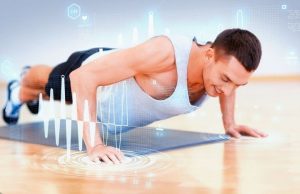
Exercise can help enhance cognitive function and protect the brain from age-related memory loss.
Regular exercise plays an important role in healthy aging and can reduce the risk of diabetes and heart disease in the future.
But you may not realize that every time you fasten your running shoes or start a spinning bike, you are also protecting your brain from age-related memory loss, including Alzheimer’s disease and dementia.
Exercise affects the brain as much as it affects the body. It doesn’t have to be too complicated! According to neurological research in January 2019, starting a simple aerobic exercise program may help improve memory, attention, organization, planning, and multitasking (also Is the executive function).
Introduce the eight best exercises that are good for brain health.
1. Sports Games
This time, screen time may actually be good for health. Sports games combine digital video games with fitness and are an interesting new way to exercise. According to a study in Mental Health Clinical Practice and Epidemiology in January 2019, virtual reality can enhance the cognitive health benefits of exercise for the elderly by improving memory and concentration.
The first generation of sports games, including Wii sports and dance, dance games. Now, a new kind of sports game is emerging. Taking virtual fitness to the next level, games specifically designed to incorporate exercise into video games.
2. High-intensity interval training
High-intensity interval training exercises are not only good for physical health; they are also one of the best exercises for brain health.
In fact, according to a small study published in Brain Sciences in February 2020, among young people, high-intensity interval training is associated with stronger brain function compared to steady-state aerobic exercise. Pushing yourself to a higher intensity may trigger the release of brain-derived neurotrophic factor (BDNF), a protein that contributes to brain health.
Brain-derived neurotrophic factor is like a fertilizer that keeps our brain cells young and vigorous, protects us from stress and helps our brain grow.
3. Outdoor sports
When it comes to the best physical exercise for the brain, it may be more cost-effective to exercise outdoors.
According to a review published in Science Advances in July 2019, spending time in nature may enhance memory, concentration, and creativity. The review found that spending time in nature is also related to reducing symptoms of stress, depression and anxiety.
Go outdoors to optimize the benefits of exercise for your brain. Whether you go hiking, snowboarding or mountain biking, you can do it outdoors.
4. Yoga
It turns out that cross-legged may also help improve the mind, not just balance. According to a review in May 2021 in Complementary Medicine, making your exercise is related to improving concentration, processing speed (how long it takes to complete a mental task), and decision-making.
Bonus points if the course includes meditation: According to data from the National Center for Complementary and Comprehensive Health, research shows that people who practice meditation often have more outer brains, which may improve their ability to process information.
5. Tai Chi
Another top exercise that is good for brain health is Tai Chi. A study published in Nature in September 2019 showed that practicing this low-intensity physical and mental exercise may help improve memory and concentration, making it a top physical exercise for brain health. Tai Chi can increase blood oxygen concentration in the brain, increase cognitive activity and enhance brain connectivity.
This may be because Tai Chi is a sport called neuromotor training, which emphasizes balance, core strength, stability and agility. The more balanced you are, the better your brain will be. Doing a form of exercise that improves balance can help you focus on tasks and regulate emotions.
6. Dancing
A study by PLOS One in July 2017 showed that dance training may increase the brain capacity of the elderly even more than traditional aerobic exercises (such as walking and cycling). According to this research, dancing also improves neuroplasticity, which means that the dancer’s brain is better able to grow and change based on experience.
That’s because dance promotes coordination, balance, endurance, interaction and communication. This allows participants to use their brains for the learning process.
7. Team sports
Whether you are joining a local volleyball league or an ultimate Frisbee team, group activities will bring a cognitive double whammy: you can get all the brain benefits of exercise, as well as the additional benefits of socialization. Social activities are related to better working memory, processing speed and decision-making ability of the elderly.
Team sports help increase the brain’s oxytocin, a hormone that can help build connections with others. The social connection is called ‘vitamin C’ because it is the most important factor in healthy aging; it is three times stronger than anything else in keeping us physically and mentally young.
8. Strength training
Resistance training can exercise muscles and brain. According to a review published in the European Review of Aging and Physical Activity in July 2019, strength training can lead to brain changes related to improved executive function.
According to a study published in Nature Medicine in January 2019, patients with Alzheimer’s disease have lower levels of irisin (a brain hormone) than people with mental health.
Although any type of resistance training has positive effects, free weight training is better. The greater the power of lifting weights, the more brain growth factors and hormones the body will release. Just doing body weight exercise may not have the same benefits.
Free weight training is also a more powerful brain booster than weightlifting machines because they require more attention. When you have a machine that supports your body, space is easier.
Recommended compound exercise, it can exercise multiple muscle groups in different directions, and requires more thinking and memory to perform.
How exercise can help your brain
With age, the size and function of the brain will decrease. In response to decreased brain activity, the capillaries in the brain begin to shrink, thereby restricting blood flow. This can lead to decreased memory, reaction time, impulse control, and decision-making abilities.
Sweating is one of the best ways to prevent age-related mental decline. Exercise increases blood flow to the brain and helps to speed up brain activity. Therefore, exercise can slow down decline and improve executive function. It also helps prevent neurological and neurodegenerative diseases such as dementia, Parkinson’s and Alzheimer’s.
How much physical exercise is needed to benefit the brain? Following the physical activity guidelines for Americans is a good starting point: 150 to 300 minutes of moderate to vigorous exercise (such as walking or hiking) per week. This is equivalent to exercising for 30 minutes at least five days a week. Or, do 75 minutes of intense training.
If 30 minutes does not feel feasible, remember that any amount of activity is better than nothing. Even if the total time is not reached, you can still get brain health benefits from any activity during the day.






